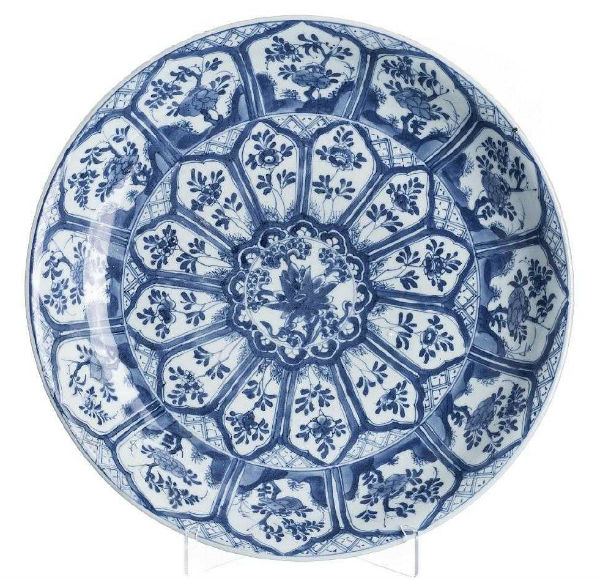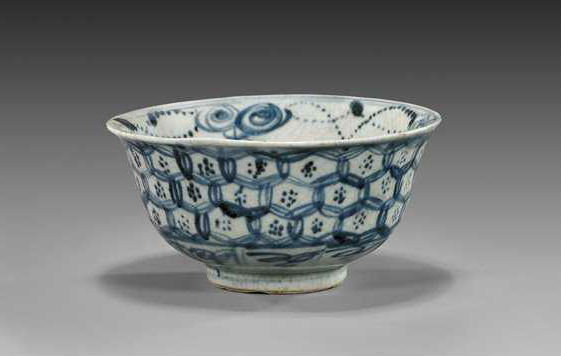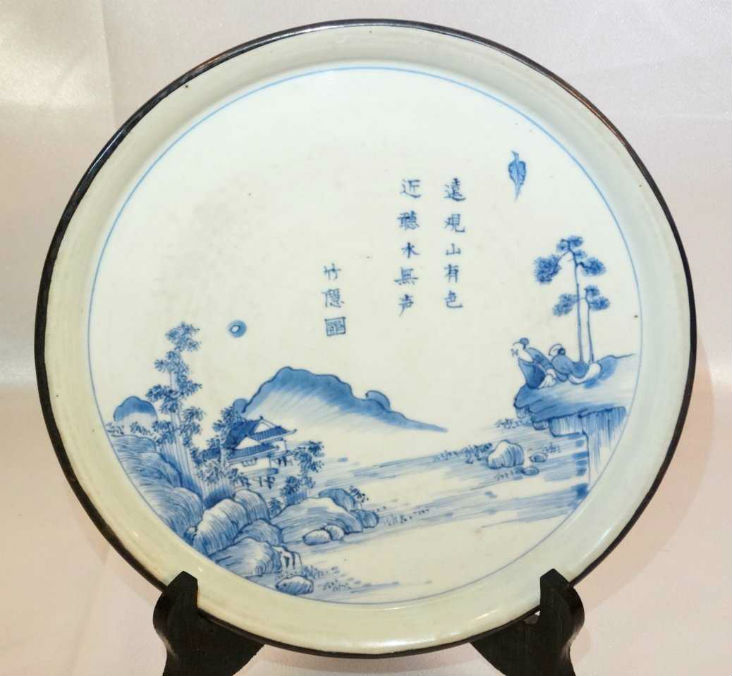
Chinese blue and white porcelain has its roots in ancient Persia. Yet with its simple color scheme, delicate durability and distinctive design, the ware has since found a place in history well beyond the Far East.
Blue and white decorative porcelain actually began as earthenware as early as the first century in China during the Tang dynasty, but little has been found other than scattered pieces to be very definitive. Therefore, a complete history of blue and white Chinese porcelain is said to begin about 1300 near Jingdezhen, Jiangxi Province, in southeastern China, now considered to be the porcelain capital of China. This is where the imperial porcelain was made beginning with the 14th century Ming dynasty.
To get that distinctive dark blue color, Chinese porcelain utilized cobalt oxide imported from Persia (Iran) and is sometimes referred to as Islamic Blue. The oxide easily withstands high temperatures once a clear overglaze is added. The cobalt oxide was such a precious import at the time that is thought to have been worth at least twice as much as gold.
Porcelain vessels were formed using white kaolin clay and then dried. The Persian cobalt oxide was ground up, mixed with water and brushed directly onto the dried pot in a dark blue decoration. A clear feldspathic glaze was added sealing the dark blue decoration against the white clay. The completed pot was fired at temperatures of about 1250 to 1500 degrees C (2282 to 2732 degrees F) to produce the distinctive blue and white Chinese porcelain. This technique was thought to have originated in Mesopotamia (Iraq) dating to the ninth century.
In time, a local source of cobalt oxide was found in China reducing the need to import the more expensive Persian supply. However, when fired, the pure Chinese cobalt oxide produced a more blue-gray color rather than the dark blue color of the Persian oxide. Later, mixing three parts Persian and two parts Chinese cobalt oxide produced a softer blue that has since been classified as “Sumatran” or “Muhammadan” blue. These variants of oxide blue can help determine the period of a particular piece from its color alone.

Periods of Blue and White Porcelain
Ming Dynasty: The beginning of the blue and white porcelain era dates from 1364. Blue and white porcelain, though, fell out of favor for the Royal Court from the beginning of the Hongwu Empire of the Ming dynasty in 1368 until the Xuande Empire in 1426. Most blue and white porcelain at that time were made for domestic consumption or exported as trade to the Islamic world.
Tianqi Porcelain: Named for the period of the reign of Emperor Tianqi from 1621 through 1628 in the late Ming dynasty, the light and dark blue color contrast in the finished porcelain designs makes this period quite distinctive. Most of the export was to Japan as part of the tea ceremony featuring small to medium sized bowls and flatware known as ko sometsuke, translated as “old blue-and-white.”
Kraak Ware: Identified easily through the use of different-sized panels, Kraak Ware was possibly named for the Portuguese ships called carracks that exported large quantities of blue and white porcelain to Europe from 1527 to 1644 or so. Each panel will have a different motif such as flowers or other traditional Chinese characteristics as envisioned by Europeans.

Kraak Ware consisted of deep bowls, plates, klaptmutsen (deep bowls with flat rims) and covered items such as wine pots, bottles and lidded boxes, which chipped easily during export. The footings, for example, are rough with pits having been fired on a bed of sand. It is not unusual for bare spots to appear along the rim where the glaze did not fire completely.
KangXi Transitional Period: From about 1620 of the Kangxi Emperor during the Qing dynasty to about 1683, production of official imperial ceramics and porcelain was suspended at Jingdezhen. During this “transitional period” potters concentrated on producing ceramics and porcelain octagonal cups, saucers and bowls with specific themes such as florals, landscapes and figural scenes in panels intended specifically for export.
Identifying Domestic vs. Export Porcelain
Early blue and white porcelain made for the domestic market will feature Chinese-type decoration such as landscapes, lotus and other flowers or plants, intricate patterns, koi fish and Buddha-themes. Chinese domestic porcelain piece consisted mainly of smaller bowls and individual tableware.
Those made for export to Europe might have a mixture of Chinese and European scenes, including family crests, while early exports to the Islamic world will feature more stylized calligraphy. Blue and white porcelain produced for export were usually thicker than those made for domestic use to reduce breakage in transport. Most items for export consisted of large serving plates, teapots, vases, covered jars and other household items not normally used in China.
What Experts Look For
How can you tell the difference between early Chinese blue and white porcelain from more contemporary pieces?
When attempting to identify Chinese porcelain of a certain era first consider the shape of the item (porcelain made for export to Japan, the Islamic world or Europe all required sizes and shapes relevant to those markets). Large plates, for example, were made only for export to Europe from the 17th century onward. Smaller cups and bowls were intended for domestic use.
Are the colors correct for the period (is the blue tone correct, for example)? Remember that the different mixtures of cobalt oxide produce different shades of blue.
Decoration must coincide with its export (European scenes were for export to Europe only; Islamic calligraphy to the region exclusively; Japanese depictions of koi, poetry and Buddha were only for that particular market.
What does the footing look like? Improvements in the production of Chinese porcelain can be gauged by how the footing at the bottom of the piece changed over time. Early on, footings were rougher, particularly those intended for export, like Kraak Ware.
The clear glazing will experience certain age characteristics for each period. There will be a brown wash along the rim after 1630 or so to help reinforce the glaze.
Compare defects in the clay its production height of the 18th century compared to other periods of advance or decline which point to characteristic aging over time.

Finally, the reign mark is examined to determine if it is correct for the period it attests to.

Imperial Reign Marks
Virtually all court porcelain was produced in Jingdezhen, with each piece produced bearing the “reign marks” on the base as underglaze, but only beginning from the Ming Dynasty of the late 14th century. There are usually six marks that are read from top to bottom, then right to left. The first two refers to the dynasty, the second two refer to the emperor and the third set translates as “made for.” In porcelain featuring only four reign marks, the first two referring to the dynasty weren’t added.
Earlier reign marks were deliberately added to later porcelain produced in the 19th century, particularly beginning with the late 14th century Ming Dynasty. It was intended as a show of respect, but it can be difficult to discern an original from a later reproduction just from reign marks alone. Guide to Marks on Chinese Porcelain by Gerald Davidson can help identify and translate reign marks.
Caution
Flaking or turning an unnatural brown or yellow color is a sign the piece has been possibly been repaired. Always use a flashlight to help find any small cracks. It’s possible that chips may have had been repaired with paste.
Delft, Faience, majolica and maiolica are tin-glazed earthenware and not considered porcelain. They each have their own history dating to Italy beginning in the ninth century. Qingbai, an earlier blue and white porcelain, has more of a jade-like transparent glaze with a bluish-green tint dating from the 12th century Song dynasty.
This quick study will help provide only a background of nearly 500 years of Chinese blue and white porcelain. It is always best, no matter the collecting category, to learn from a variety of resources, visit auctions and always consult with experts.
Resources
Chinese-antique-porcelain.com, Identifying Chinese Porcelain, undated
Gauchet, Jean, Expert Jean Gauchet Explains Kangxi Porcelain, gauchet-expert.com, undated
Gristina, Margaret, Collecting Guide: 7 things to consider when collecting Chinese porcelains, Christies.com, March 5, 2018.
Jefferson Patterson Park & Museum State Museum of Archaeology (Maryland), Chinese Porcelain, jefpat.org, 2002
Masahiko Sato, Chinese Ceramics: A Short History, Weatherhill, New York and Tokyo, 1981
Ho, Joan, Blue notes: A guide to Chinese blue-and-white porcelain, Christies.com, March 28, 2018
Hunt, Kate, Demystifying Chinese reign marks — everything you need to know to get started, Christies.com, April 25, 2017
MacGuire, Becky, Collecting Guide: Chinese export porcelain, Christies.com, Dec. 17, 2018.
Wikipedia.com, Chinese export porcelain, undated



